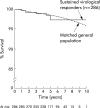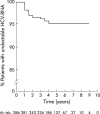Long term clinical outcome of chronic hepatitis C patients with sustained virological response to interferon monotherapy
- PMID: 15361504
- PMCID: PMC1774235
- DOI: 10.1136/gut.2003.038257
Long term clinical outcome of chronic hepatitis C patients with sustained virological response to interferon monotherapy
Abstract
Background: The key end point for treatment efficacy in chronic hepatitis C is absence of detectable virus at six months after treatment. However, the incidence of clinical events during long term follow up of patients with sustained virological response is still poorly documented and may differ between the Eastern and Western world.
Aims: To assess clinical end points during long term follow up of European patients with a sustained virological response to interferon monotherapy.
Methods: Meta-analysis of individual patient data from eight European protocolled follow up studies of interferon treatment for chronic hepatitis C.
Results: A total of 286 sustained virological responders and 50 biochemical responders (detectable virus but normal alanine aminotransferase levels) were followed up for 59 months. Fifteen sustained virological responders (5.2%) had cirrhosis before treatment and 112 (39%) had genotype 1. The late virological relapse rate after five years of follow up was 4.7% (95% confidence interval (CI) 2.0-7.4) among sustained virological responders; all late relapses occurred within four years after treatment. Among sustained virological responders, the rate of decompensation after five years of follow up was 1.0% (95% CI 0.0-2.3) and none developed hepatocellular carcinoma (HCC). Survival was comparable with the general population, matched for age and sex, the standard mortality ratio being 1.4 (95% CI 0.3-2.5). Clinical outcome of patients with cirrhosis was similar to other sustained virological responders. For biochemical responders, the rates of development of decompensation and HCC during long term follow up were 9.1% (95% CI 0.5-17.7) and 7.1% (95% CI 0-15.0), respectively.
Conclusions: Five year survival of European sustained virological responders was similar to the overall population, matched for age and sex. No HCCs were detected during long term follow up.
Figures



Similar articles
-
Interferon treatment improves survival in chronic hepatitis C patients showing biochemical as well as virological responses by preventing liver-related death.J Viral Hepat. 2004 Mar;11(2):148-56. doi: 10.1046/j.1365-2893.2003.00481.x. J Viral Hepat. 2004. PMID: 14996350
-
Long-term outcomes of chronic hepatitis C patients with sustained virological response at 6 months after the end of treatment.World J Gastroenterol. 2006 Sep 14;12(34):5532-5. doi: 10.3748/wjg.v12.i34.5532. World J Gastroenterol. 2006. PMID: 17006994 Free PMC article.
-
Long-term follow-up of chronic hepatitis C patients with sustained virological response to various forms of interferon-based anti-viral therapy.Aliment Pharmacol Ther. 2006 Feb 15;23(4):507-11. doi: 10.1111/j.1365-2036.2006.02785.x. Aliment Pharmacol Ther. 2006. PMID: 16441471
-
Long-term effects of interferon-based therapy for chronic hepatitis C.Oncology. 2007;72 Suppl 1:16-23. doi: 10.1159/000111703. Epub 2007 Dec 13. Oncology. 2007. PMID: 18087178 Review.
-
A comprehensive long-term prognosis of chronic hepatitis C patients with antiviral therapy: a meta-analysis of studies from 2008 to 2014.Hepat Mon. 2015 May 23;15(5):e27181. doi: 10.5812/hepatmon.15(5)2015.27181. eCollection 2015 May. Hepat Mon. 2015. PMID: 26045707 Free PMC article. Review.
Cited by
-
Hepatic steatosis as a possible risk factor for the development of hepatocellular carcinoma after eradication of hepatitis C virus with antiviral therapy in patients with chronic hepatitis C.World J Gastroenterol. 2007 Oct 21;13(39):5180-7. doi: 10.3748/wjg.v13.i39.5180. World J Gastroenterol. 2007. PMID: 17876888 Free PMC article.
-
Hepatitis C and general practice: the crucial role of primary care in stemming the epidemic.Br J Gen Pract. 2005 Apr;55(513):259-60. Br J Gen Pract. 2005. PMID: 15826430 Free PMC article. No abstract available.
-
Hepatitis C, disease and its management: a cost-effectiveness analysis of the new generation oral protease inhibitors.Antivir Ther. 2015;20(8):827-33. doi: 10.3851/IMP2986. Epub 2015 Aug 26. Antivir Ther. 2015. PMID: 26555064 Free PMC article.
-
Effect of sustained virological response on long-term clinical outcome in 113 patients with compensated hepatitis C-related cirrhosis treated by interferon alpha and ribavirin.World J Gastroenterol. 2007 Nov 14;13(42):5648-53. doi: 10.3748/wjg.v13.i42.5648. World J Gastroenterol. 2007. PMID: 17948941 Free PMC article.
-
Predictors of sustained virological response to a 48-week course of pegylated interferon alfa-2a and ribavirin in patients infected with hepatitis C virus genotype 4.Ann Saudi Med. 2009 Jan-Feb;29(1):4-14. doi: 10.4103/0256-4947.51816. Ann Saudi Med. 2009. PMID: 19139619 Free PMC article.
References
-
- Hopf U , Kuther S, Konig V, et al. (Long-term follow-up of chronic hepatitis C after treatment with recombinant interferon alpha-2a). Z Gastroenterol 1994;32:425–30. - PubMed
-
- Hopf U , Berg T, Konig V, et al. Treatment of chronic hepatitis C with interferon alpha: long-term follow-up and prognostic relevance of HCV genotypes. J Hepatol 1996;24 (suppl 2) :67–73. - PubMed
-
- Marcellin P , Boyer N, Degott C, et al. Long-term histologic and viral changes in patients with chronic hepatitis C who responded to alpha interferon. Liver 1994;14:302–7. - PubMed
-
- Marcellin P , Boyer N, Gervais A, et al. Long-term histologic improvement and loss of detectable intrahepatic HCV RNA in patients with chronic hepatitis C and sustained response to interferon-alpha therapy. Ann Intern Med 1997;127:875–81. - PubMed
-
- Reichard O , Glaumann H, Fryden A, et al. Two-year biochemical, virological, and histological follow-up in patients with chronic hepatitis C responding in a sustained fashion to interferon alfa-2b treatment. Hepatology 1995;21:918–22. - PubMed
Publication types
MeSH terms
Substances
LinkOut - more resources
Full Text Sources
Other Literature Sources
